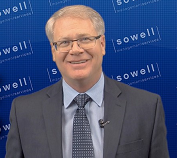Friday Quick Take: Jobs, France, Buffett and Oil
There are several items in focus this morning including Warren Buffett's big meeting (as well as his take on both IBM and Apple), the election in France on Sunday (Macron continues to hold a 20-point lead - but strange things have been happening at voting booths around the world lately), the latest move in oil (don't look now, but oil was trading below $44 this morning based on supply concerns - and remains something to watch), and of course, the Big Kahuna of economic data - the Jobs Report.
The latter is attracting most of the attention at the moment as job creation in April rebounded from the surprisingly weak March reading. According to the Labor Department, the U.S. economy created 211,000 jobs last month, which was above the consensus expectation for 185,000.
Next, the nation's official Unemployment Rate fell to 4.4%, which was down from March's reading of 4.5% and two-tenths below analysts expectations of 4.6%. It is worth noting that the current level is the lowest seen since May 2007.
However, there are numerous ways to look at the rate of the unemployed. For example, there is the now-popular U-6 rate, which includes those not actively looking for jobs and folks looking for part-time work. The U-6 dropped to 8.6% in April, which is down from the 8.9% level in March, and the best reading since November 2007.
Another way to view unemployment is to take the number of employed people relative to the population. This ratio rose to 60.2% in April, which is the highest level seen since February 2009.
As usual, there were revisions to the prior two months' job creation totals. March was revised down to 79K from 98K while February's numbers went up to 232K from 219K.
On the income front, Average Hourly Earnings rose by 0.3% in April to $26.19 per hour and hourly wages grew by 2.5% on a year-over-year basis.
The Takeaway
What jumps out at me in this report is the "best reading since" numbers. For example, the Unemployment Rate is the best since May 2007. The U-6 is the best since November 2007. And the ratio of employed-to-population is the highest since February 2009.
Thus, it is fairly easy to argue that the jobs market has returned to levels seen before the Great Recession. And as such, the Fed is justified in returning rates to more normalized levels.
In addition, it would appear that the Fed's view that the weakness seen in Q1 may indeed have been "transitory" as hiring clearly perked up again after March's hiccup. And from a big-picture standpoint, I believe the idea of the economy rebounding from the usual late-winter swoon is critical to the current market levels and trader narrative. Therefore, we need to continue to watch the incoming data in May/June for signs of confirmation.
Thought For The Day:
Remember that it pays to be open minded (in more ways than one)...
Current Market Drivers
We strive to identify the driving forces behind the market action on a daily basis. The thinking is that if we can both identify and understand why stocks are doing what they are doing on a short-term basis; we are not likely to be surprised/blind-sided by a big move. Listed below are what we believe to be the driving forces of the current market (Listed in order of importance).
1. The State of Trump Administration Policies
2. The State of the U.S. Economy
3. The State of Earning Season
4. The State of World Politics
Wishing you green screens and all the best for a great day,

David D. Moenning
Chief Investment Officer
Sowell Management Services
Disclosure: At the time of publication, Mr. Moenning and/or Sowell Management Services held long positions in the following securities mentioned: none. Note that positions may change at any time.
Looking for a "Modern" approach to Asset Allocation and Portfolio Design?
Looking for More on the State of the Markets?
Disclosures
The opinions and forecasts expressed herein are those of Mr. David Moenning and may not actually come to pass. Mr. Moenning's opinions and viewpoints regarding the future of the markets should not be construed as recommendations. The analysis and information in this report is for informational purposes only. No part of the material presented in this report is intended as an investment recommendation or investment advice. Neither the information nor any opinion expressed constitutes a solicitation to purchase or sell securities or any investment program.
Any investment decisions must in all cases be made by the reader or by his or her investment adviser. Do NOT ever purchase any security without doing sufficient research. There is no guarantee that the investment objectives outlined will actually come to pass. All opinions expressed herein are subject to change without notice. Neither the editor, employees, nor any of their affiliates shall have any liability for any loss sustained by anyone who has relied on the information provided.
The analysis provided is based on both technical and fundamental research and is provided "as is" without warranty of any kind, either expressed or implied. Although the information contained is derived from sources which are believed to be reliable, they cannot be guaranteed.
David D. Moenning is an investment adviser representative of Sowell Management Services, a registered investment advisor. For a complete description of investment risks, fees and services, review the firm brochure (ADV Part 2) which is available by contacting Sowell. Sowell is not registered as a broker-dealer.
Employees and affiliates of Sowell may at times have positions in the securities referred to and may make purchases or sales of these securities while publications are in circulation. Positions may change at any time.
Investments in equities carry an inherent element of risk including the potential for significant loss of principal. Past performance is not an indication of future results.
Advisory services are offered through Sowell Management Services.
